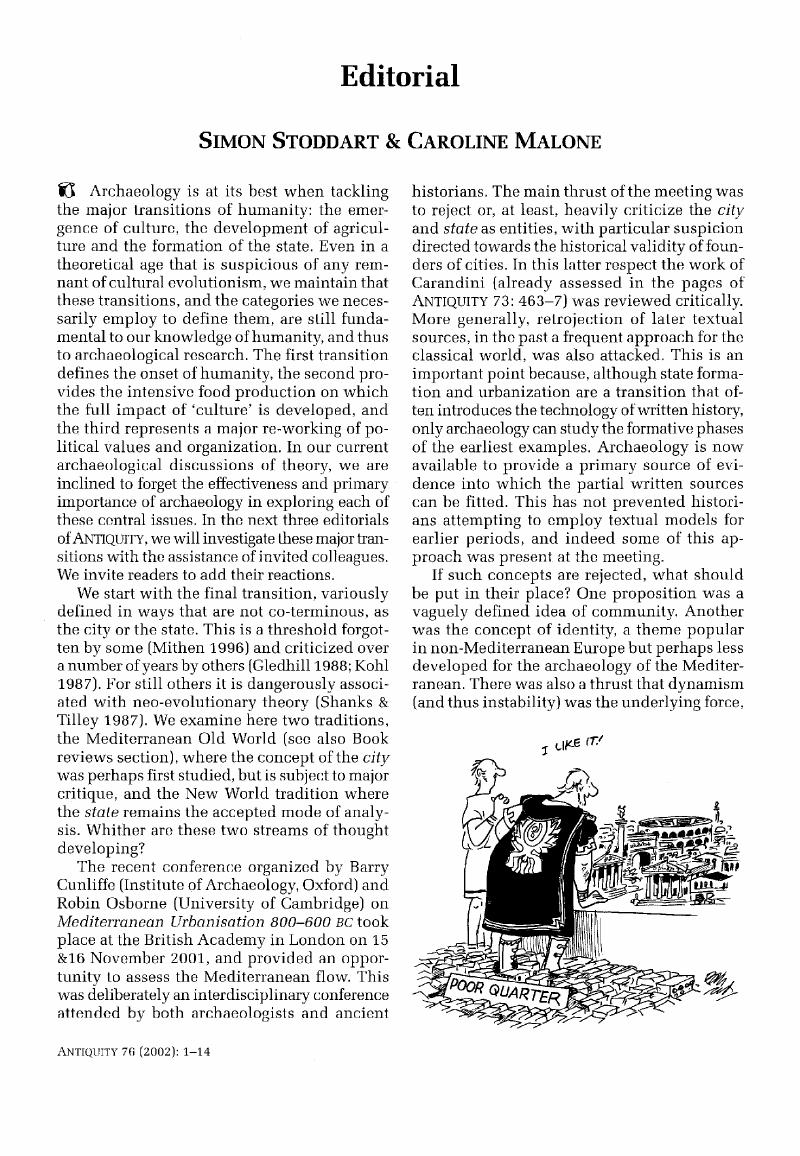No CrossRef data available.
Article contents
Editorial
Published online by Cambridge University Press: 02 January 2015
Abstract
An abstract is not available for this content so a preview has been provided. As you have access to this content, a full PDF is available via the ‘Save PDF’ action button.

- Type
- Editorial
- Information
- Copyright
- Copyright © Antiquity Publications Ltd. 2002
References
References
Blanton, R.
1998. Beyond centralization: Steps towards a theory of egalitarian behavior in archaic states, in Feinman, & Marcus, (ed.), Archaic States: 135–72. Santa Fe (NM): School of American Research.Google Scholar
Blanton, R., Feinman, G., Kowalewski, S. & Peregrine, P.. 1996. A dual-processual theory for the evolution of Mesoamerican civilization, Current Anthropology
37: 1–14.CrossRefGoogle Scholar
Brumfiel, E.
1992. Distinguished lecture in archaeology: Breaking and entering the ecosystem — gender, class and faction steal the show, American Anthropologist
94: 551–67.Google Scholar
Brumfiel, K. & Fox, J.. 1994. Factional competition and political development in the New World. Cambridge: Cambridge University Press.Google Scholar
Demarrais, K, Castillo, L. J. & Earle, T. 1996. Ideology, materialization, and power strategies, Current Anthropology
37: 15–85.Google Scholar
Feinman, G. & Marcus, J. (ed.). 1998. Archaic states. Santa Fe (NM): School of American Research Press.Google Scholar
Hare, T.
2000. Between the household and the empire: structural relationships within and among Aztec communities and politics, in CanuLo, M. & Yaeger, J. (ed.), The archaeology of communities: a New World perspective:
78–101. London: Routledge.Google Scholar
Johnson, M.
2000. Self-made men and the staging of agency, in Dobres, & Robb, (ed.), Agency in archaeology:
213–31. London: Routledge.Google Scholar
Marcus, J.
1993. Ancient Maya political organization, in Sabloff, J. & Henderson, J. (ed.), Lowland Maya civilization in the 8th century AD:
111–83. Washington (DC): Dumbarton Oaks.Google Scholar
Marcus, J.
1998. The peaks and valleys of ancient stales: An extension of the dynamic model, in Feinman & Marcus (ed.): 59–94.Google Scholar
References
Carandini, A.
1997. La nascita di Roma. Dèi, Lari, Eroi e Uomini all’alba di una civiltà. Torino: Giulio Einaudi Editori.Google Scholar
Carandini, A. & Cappelli, R. (ed.). 2000. Roma. Romolo, Remo e la fondazione della città. Milano: Electa.Google Scholar
Flannery, K. V.
1999. Process and agency in early state formation, Cambridge Archaeological Journal
9(1): 3–21.Google Scholar
Gledhill, J.
1988. Introduction. The comparative analysis of social and political transitions, in Gledhill, J., Bender, B. & Larsen, T. (ed.), State and society: 3–21. London: Unwin & Hyman.Google Scholar
Kohl, P. L.
1987. State formation: useful concept or idée fixe?, in Patterson, T. & Gailey, C. W. (ed.), Power relations and State formation:
27–34. Washington (DC): American Anthropological Association.Google Scholar
Mithen, S. J.
1996. The prehistory of the mind: a scarch for the origins of art, science and religion. London: Thames & Hudson.Google Scholar
Rainbird, P. & Hamilakis, Y.. 2001. Interrogating pedagogies. Archaeology in higher education. (Lampeter Workshop in Archaeology 3). Oxford: British Archaeological Reports. International series S948.Google Scholar
References
Giot, P.-R.
1987. Barnenez Carn Guennoc. Rennes: Travaux du Laboratoire ‘Anthropologie–Préhistoire–Protohistoire et Quaternaire Armoricains — Rennes’.Google Scholar
Giot, P.-R.
1997. Chronique de préhistoire et de protohistoire finistériennes et des archéosciences pour 1996, Bullelin de la Société archéologique du Finistère
126: 11–32.Google Scholar
Monnier, J.-L. & Langouet, L. (ed.). 1990. La Bretagne et L’Europe Préhistoriques. Mémoire en hommage à Pierre-Roland Giot. Rennes: Revue Archéologique de l’Ouest. Supplément 2 (1990).Google Scholar
Jones, R. & Megaw, V.. 2000. Confessions of a wild colonial boy, Australian Archaeology
50: 12–26.Google Scholar
Anderson, A., Lilley, I. & O’Connor, S. (ed.). 2001. Histories of old ages: Essays in Honour of Rhys Jones. Canberra: Pandanus Books, The Australian National University.Google Scholar


